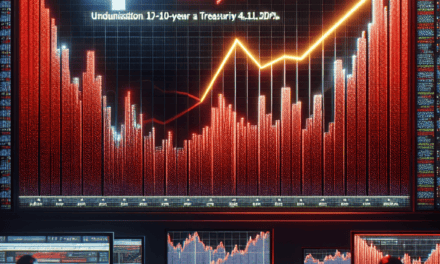“Unlock Your Future: Invest $500 in the Top S&P 500 ETF Today!”
Introduction
Investing in the S&P 500 ETF is a strategic way to gain exposure to the performance of the 500 largest publicly traded companies in the U.S. With a $500 investment today, you can diversify your portfolio and potentially benefit from the long-term growth of the stock market. The S&P 500 ETF offers a low-cost entry point, allowing investors to participate in a broad range of sectors, including technology, healthcare, and consumer goods. This investment vehicle is designed for both novice and experienced investors seeking to capitalize on the overall market trends while minimizing individual stock risk.
Best S&P 500 ETFs for $500 Investment
Investing in the stock market can be a daunting task, especially for those who are new to the world of finance. However, exchange-traded funds (ETFs) have emerged as a popular choice for investors seeking diversification and lower costs. Among the various options available, S&P 500 ETFs stand out due to their ability to track the performance of the 500 largest publicly traded companies in the United States. For individuals looking to make a $500 investment today, selecting the right S&P 500 ETF can be crucial for maximizing returns while minimizing risk.
One of the most well-known S&P 500 ETFs is the SPDR S&P 500 ETF Trust (SPY). Launched in 1993, SPY has become a staple in many investors’ portfolios due to its liquidity and low expense ratio. With an expense ratio of just 0.09%, it allows investors to gain exposure to the S&P 500 without incurring significant costs. Furthermore, SPY’s high trading volume ensures that investors can easily buy and sell shares, making it an attractive option for those who may want to adjust their positions frequently.
Another noteworthy option is the Vanguard S&P 500 ETF (VOO). Vanguard is renowned for its commitment to low-cost investing, and VOO exemplifies this philosophy with an expense ratio of only 0.03%. This ETF not only provides exposure to the S&P 500 but also benefits from Vanguard’s reputation for strong management and investor-friendly practices. For a $500 investment, VOO offers a compelling choice, particularly for long-term investors who prioritize cost efficiency and stability.
In addition to SPY and VOO, the iShares Core S&P 500 ETF (IVV) is another excellent candidate for those looking to invest in the S&P 500. With an expense ratio of 0.03%, IVV is on par with VOO in terms of cost-effectiveness. One of the advantages of IVV is its structure, which allows for tax efficiency, making it a suitable option for taxable accounts. Moreover, IVV has a strong track record of performance, making it a reliable choice for investors seeking to grow their capital over time.
For those who are particularly interested in a more innovative approach, the Invesco S&P 500 Equal Weight ETF (RSP) offers a unique twist on traditional S&P 500 investing. Unlike standard S&P 500 ETFs that weight companies based on their market capitalization, RSP gives equal weight to all 500 companies. This strategy can lead to different performance outcomes, particularly in volatile markets. While RSP has a slightly higher expense ratio of 0.40%, its distinct approach may appeal to investors looking for diversification beyond market cap weighting.
As investors consider their options, it is essential to evaluate not only the expense ratios but also the performance history and liquidity of each ETF. A $500 investment can grow significantly over time, especially when invested in a well-managed ETF that tracks the S&P 500. Additionally, investors should consider their own financial goals and risk tolerance when selecting an ETF. By doing so, they can make informed decisions that align with their investment strategies.
In conclusion, the best S&P 500 ETFs for a $500 investment today include SPY, VOO, IVV, and RSP. Each of these options offers unique benefits, allowing investors to choose based on their individual preferences and investment objectives. By carefully considering these factors, investors can position themselves for potential growth in the ever-evolving landscape of the stock market.
How to Choose an S&P 500 ETF with $500
Investing in an S&P 500 ETF can be an excellent way to gain exposure to the broader U.S. stock market, especially for those looking to start with a modest investment of $500. However, selecting the right ETF requires careful consideration of several factors to ensure that your investment aligns with your financial goals and risk tolerance. First and foremost, it is essential to understand the concept of an ETF, or exchange-traded fund. An ETF is a type of investment fund that holds a collection of assets, such as stocks, and trades on an exchange like a stock. S&P 500 ETFs specifically track the performance of the S&P 500 index, which comprises 500 of the largest publicly traded companies in the United States.
When choosing an S&P 500 ETF, one of the primary factors to consider is the expense ratio. The expense ratio represents the annual fees that fund managers charge to manage the ETF, expressed as a percentage of the fund’s assets. Lower expense ratios are generally preferable, as they allow investors to retain more of their returns over time. For a $500 investment, even a small difference in expense ratios can significantly impact long-term growth. Therefore, it is advisable to compare the expense ratios of various S&P 500 ETFs to identify the most cost-effective option.
In addition to expense ratios, investors should also evaluate the liquidity of the ETF. Liquidity refers to how easily an asset can be bought or sold in the market without affecting its price. Higher liquidity typically results in tighter bid-ask spreads, which can reduce trading costs. When investing in an S&P 500 ETF, it is beneficial to choose one with a high average daily trading volume, as this indicates that the ETF is actively traded and can be bought or sold with relative ease.
Another critical aspect to consider is the tracking error of the ETF. Tracking error measures how closely the ETF’s performance aligns with that of the S&P 500 index. A lower tracking error indicates that the ETF is effectively replicating the index’s performance, which is a desirable characteristic for investors seeking to mirror the market. Therefore, reviewing the historical tracking error of potential ETFs can provide valuable insights into their performance consistency.
Furthermore, it is essential to assess the fund’s size and age. Generally, larger and more established ETFs tend to be more stable and reliable. A well-established fund is likely to have a proven track record and a more extensive history of performance data, which can aid in making informed investment decisions. Conversely, newer or smaller ETFs may carry higher risks due to their limited operating history and lower asset bases.
Lastly, consider the brokerage platform through which you plan to invest. Some platforms may offer commission-free trading for certain ETFs, which can be particularly advantageous for a $500 investment. By minimizing transaction costs, you can maximize the amount of your investment that goes toward purchasing shares of the ETF.
In conclusion, selecting the right S&P 500 ETF for a $500 investment involves evaluating several key factors, including expense ratios, liquidity, tracking error, fund size, and the brokerage platform. By carefully considering these elements, investors can make informed decisions that align with their financial objectives and ultimately enhance their investment experience in the stock market.
Top Performing S&P 500 ETFs for Small Investors
Investing in the stock market can often seem daunting, especially for small investors who may feel overwhelmed by the vast array of options available. However, exchange-traded funds (ETFs) have emerged as a popular choice, particularly for those looking to invest modest amounts, such as $500. Among the various types of ETFs, those that track the S&P 500 index stand out due to their potential for long-term growth and diversification. As such, identifying the top-performing S&P 500 ETFs can provide small investors with a solid foundation for their investment journey.
One of the most notable S&P 500 ETFs is the SPDR S&P 500 ETF Trust (SPY). Launched in 1993, SPY has established itself as one of the largest and most liquid ETFs in the world. Its structure allows investors to gain exposure to the 500 largest publicly traded companies in the United States, making it an excellent choice for those seeking broad market exposure. With a low expense ratio, SPY is particularly appealing for small investors who want to minimize costs while maximizing potential returns. Furthermore, its historical performance has consistently mirrored that of the S&P 500 index, providing a reliable option for those looking to invest in a diversified portfolio.
Another strong contender is the Vanguard S&P 500 ETF (VOO). Vanguard is renowned for its commitment to low-cost investing, and VOO exemplifies this philosophy with its competitive expense ratio. This ETF not only tracks the performance of the S&P 500 but also offers the added benefit of Vanguard’s reputation for investor-friendly practices. For small investors, VOO represents a straightforward way to gain exposure to the U.S. equity market without incurring high fees. Additionally, Vanguard’s emphasis on long-term investing aligns well with the goals of many small investors, making VOO a compelling option.
In addition to SPY and VOO, the iShares Core S&P 500 ETF (IVV) is another noteworthy choice. Similar to its counterparts, IVV aims to replicate the performance of the S&P 500 index, but it distinguishes itself with a slightly lower expense ratio. This can be particularly advantageous for small investors who are looking to maximize their returns over time. Moreover, IVV’s structure allows for seamless trading, making it an attractive option for those who may want to adjust their investments as market conditions change.
As small investors consider their options, it is essential to recognize the importance of diversification. Investing in an S&P 500 ETF inherently provides this benefit, as these funds encompass a wide range of sectors and industries. This diversification can help mitigate risk, which is particularly crucial for those with limited capital. By investing in a single ETF, small investors can gain exposure to a broad swath of the market, reducing the impact of any single stock’s poor performance on their overall portfolio.
Ultimately, the decision to invest in an S&P 500 ETF should be guided by individual financial goals and risk tolerance. While SPY, VOO, and IVV are all excellent choices for small investors looking to make a $500 investment, it is essential to conduct thorough research and consider factors such as expense ratios, historical performance, and personal investment strategies. By doing so, small investors can confidently navigate the world of ETFs and take meaningful steps toward building a robust investment portfolio.
Diversification Benefits of Investing $500 in S&P 500 ETFs
Investing in the stock market can often seem daunting, especially for those who are new to the world of finance. However, one of the most effective ways to mitigate risk while still gaining exposure to the market is through exchange-traded funds (ETFs), particularly those that track the S&P 500 index. With a modest investment of $500, individuals can harness the diversification benefits that come with investing in an S&P 500 ETF, making it an appealing option for both novice and seasoned investors alike.
To begin with, the S&P 500 index comprises 500 of the largest publicly traded companies in the United States, spanning various sectors such as technology, healthcare, finance, and consumer goods. By investing in an S&P 500 ETF, investors gain instant exposure to a broad array of companies, which significantly reduces the risk associated with investing in individual stocks. This diversification is crucial because it helps to cushion the impact of poor performance from any single company. For instance, if one company within the index experiences a downturn, the overall effect on the ETF is likely to be minimal, as the performance of other companies can offset those losses.
Moreover, the low cost of entry associated with ETFs makes them particularly attractive for those looking to invest smaller amounts, such as $500. Unlike mutual funds, which often require higher minimum investments, ETFs can be purchased in shares, allowing investors to buy a fraction of the index without needing a substantial capital outlay. This accessibility democratizes investment opportunities, enabling individuals from various financial backgrounds to participate in the stock market and benefit from its long-term growth potential.
In addition to the inherent diversification benefits, investing in an S&P 500 ETF also provides exposure to the overall performance of the U.S. economy. Historically, the S&P 500 has delivered robust returns over the long term, making it a reliable choice for investors seeking capital appreciation. By allocating $500 to an S&P 500 ETF, investors are not only diversifying their portfolios but also aligning themselves with the broader economic trends that drive growth in the stock market. This alignment can be particularly advantageous during periods of economic expansion, as the companies within the index are often at the forefront of innovation and market leadership.
Furthermore, many S&P 500 ETFs come with low expense ratios, which means that investors can keep more of their returns rather than paying high management fees. This cost efficiency is particularly beneficial for those investing smaller amounts, as it allows for a greater portion of the initial investment to remain invested in the market. Over time, even small savings on fees can compound significantly, enhancing overall returns.
In conclusion, investing $500 in an S&P 500 ETF offers a compelling opportunity for individuals seeking to diversify their portfolios while gaining exposure to the performance of some of the largest and most successful companies in the United States. The combination of broad market exposure, low costs, and the potential for long-term growth makes S&P 500 ETFs an attractive option for both new and experienced investors. By taking this step, individuals can not only enhance their investment strategies but also build a foundation for future financial success.
Long-Term Growth Potential of S&P 500 ETFs with $500
Investing in the stock market can be a daunting task, especially for those who are new to the world of finance. However, exchange-traded funds (ETFs) that track the S&P 500 index offer a compelling option for investors looking to grow their wealth over the long term. With a modest investment of $500, individuals can gain exposure to a diversified portfolio of some of the largest and most successful companies in the United States. This approach not only mitigates risk but also positions investors to benefit from the overall growth of the economy.
One of the primary advantages of investing in S&P 500 ETFs is their inherent diversification. By purchasing a single ETF, investors effectively buy shares in 500 different companies, spanning various sectors such as technology, healthcare, consumer goods, and financial services. This diversification reduces the impact of poor performance from any single stock, thereby enhancing the stability of the investment. As a result, even with a relatively small investment, individuals can participate in the potential upside of the broader market.
Moreover, the historical performance of the S&P 500 index underscores its long-term growth potential. Over the past several decades, the index has delivered an average annual return of approximately 10% before inflation. While past performance is not indicative of future results, this historical trend suggests that investing in an S&P 500 ETF can be a sound strategy for those looking to build wealth over time. By committing to a long-term investment horizon, investors can ride out market volatility and benefit from the compounding effect of returns.
In addition to historical performance, the low expense ratios associated with many S&P 500 ETFs make them an attractive option for cost-conscious investors. Unlike actively managed funds, which often charge higher fees for their management services, many S&P 500 ETFs have minimal management fees. This cost efficiency allows investors to retain a larger portion of their returns, further enhancing the potential for growth. For a $500 investment, even small differences in fees can significantly impact overall returns over time.
Furthermore, the accessibility of S&P 500 ETFs is another factor that makes them appealing to new investors. With the rise of online brokerage platforms, individuals can easily purchase shares of these ETFs with minimal transaction costs. This ease of access democratizes investing, allowing anyone with a modest amount of capital to participate in the stock market. As a result, even those who may have previously felt excluded from investing can now take advantage of the growth potential offered by S&P 500 ETFs.
In conclusion, investing $500 in an S&P 500 ETF can be a prudent decision for those seeking long-term growth. The combination of diversification, historical performance, low fees, and accessibility makes these ETFs an attractive option for both novice and experienced investors alike. By taking a long-term approach and remaining committed to their investment strategy, individuals can harness the power of the stock market to build wealth over time. As the economy continues to evolve, S&P 500 ETFs stand poised to capture the growth potential of some of the most successful companies in the United States, making them a valuable addition to any investment portfolio.
Comparing Expense Ratios of S&P 500 ETFs for $500
When considering an investment in an S&P 500 ETF with a modest sum of $500, one of the most critical factors to evaluate is the expense ratio. The expense ratio represents the annual fees that fund managers charge to cover the operational costs of managing the ETF. These fees are expressed as a percentage of the fund’s average assets under management and can significantly impact long-term returns, especially for smaller investments. Therefore, understanding the nuances of expense ratios among various S&P 500 ETFs is essential for making an informed decision.
To begin with, it is important to recognize that S&P 500 ETFs generally have lower expense ratios compared to actively managed funds. This is primarily due to their passive management style, which aims to replicate the performance of the S&P 500 index rather than attempting to outperform it. Consequently, many investors are drawn to these ETFs for their cost-effectiveness. For instance, some of the most popular S&P 500 ETFs, such as the SPDR S&P 500 ETF Trust (SPY) and the Vanguard S&P 500 ETF (VOO), boast expense ratios that are remarkably low, often below 0.1%. This means that for every $1,000 invested, the annual fee would be just $1, making them attractive options for investors looking to maximize their returns.
Moreover, while low expense ratios are a significant advantage, it is also essential to consider other factors that may influence the overall investment experience. For example, trading costs and bid-ask spreads can vary among different ETFs, which can affect the effective cost of investing. Even with a low expense ratio, an ETF with a high bid-ask spread may not be as cost-effective as it appears. Therefore, investors should look beyond just the expense ratio and consider the total cost of ownership when evaluating their options.
In addition to SPY and VOO, other S&P 500 ETFs, such as the iShares Core S&P 500 ETF (IVV) and the Schwab S&P 500 Index Fund (SCHX), also offer competitive expense ratios. IVV, for instance, has an expense ratio of 0.03%, making it one of the most cost-effective choices available. Similarly, SCHX offers an expense ratio of 0.03%, which is appealing for investors who prioritize low costs. By comparing these options, investors can identify which ETF aligns best with their financial goals and investment strategy.
Furthermore, it is worth noting that while expense ratios are crucial, they should not be the sole determinant in selecting an ETF. Factors such as fund size, liquidity, and historical performance should also be taken into account. A larger fund may provide better liquidity, which can be particularly important for investors who plan to trade frequently. Additionally, examining the historical performance of the ETF can provide insights into how well it has tracked the S&P 500 index over time.
In conclusion, when investing $500 in an S&P 500 ETF, comparing expense ratios is a vital step in the decision-making process. By focusing on ETFs with low expense ratios, such as SPY, VOO, IVV, and SCHX, investors can enhance their potential returns. However, it is equally important to consider other factors, including trading costs and fund liquidity, to ensure a well-rounded investment choice. Ultimately, a thoughtful approach to selecting an S&P 500 ETF can lead to a more rewarding investment experience.
Strategies for Maximizing Returns on a $500 S&P 500 ETF Investment
Investing in an S&P 500 ETF can be a prudent choice for individuals looking to grow their wealth over time, especially with a modest initial investment of $500. To maximize returns on this investment, it is essential to adopt a strategic approach that encompasses various aspects of market engagement, risk management, and long-term planning. One of the first strategies to consider is the importance of dollar-cost averaging. This technique involves consistently investing a fixed amount of money at regular intervals, regardless of market conditions. By doing so, investors can mitigate the impact of market volatility, as they will purchase more shares when prices are low and fewer shares when prices are high. This disciplined approach can lead to a lower average cost per share over time, ultimately enhancing overall returns.
In addition to dollar-cost averaging, it is crucial to select the right S&P 500 ETF that aligns with one’s investment goals. While many ETFs track the S&P 500 index, they may differ in terms of expense ratios, tracking error, and dividend yields. Lower expense ratios are particularly important, as high fees can erode returns over time. Therefore, investors should conduct thorough research to identify an ETF that not only has a strong historical performance but also offers a competitive fee structure. Furthermore, considering the ETF’s dividend yield can provide an additional source of income, which can be reinvested to purchase more shares, thereby compounding returns.
Another effective strategy is to maintain a long-term perspective. The stock market can be unpredictable in the short term, with fluctuations driven by various factors such as economic data, geopolitical events, and investor sentiment. However, historically, the S&P 500 has demonstrated resilience and growth over extended periods. By committing to a long-term investment horizon, investors can ride out market volatility and benefit from the overall upward trajectory of the index. This approach not only reduces the temptation to react impulsively to market downturns but also allows for the compounding of returns, which can significantly enhance the value of the initial investment.
Moreover, it is essential to stay informed about market trends and economic indicators that may impact the S&P 500. By keeping abreast of developments such as interest rate changes, inflation rates, and corporate earnings reports, investors can make more informed decisions regarding their investments. This knowledge can also help in identifying potential opportunities for rebalancing the portfolio or adjusting the investment strategy as needed. For instance, if certain sectors within the S&P 500 are expected to outperform due to favorable economic conditions, reallocating funds to those sectors may yield higher returns.
Lastly, it is advisable to avoid emotional decision-making when investing in an S&P 500 ETF. The fear of missing out or the anxiety of market downturns can lead to hasty decisions that may not align with one’s long-term investment strategy. Instead, maintaining a disciplined approach and adhering to a well-thought-out investment plan can help investors stay focused on their goals. By combining these strategies—dollar-cost averaging, selecting the right ETF, maintaining a long-term perspective, staying informed, and avoiding emotional decisions—investors can significantly enhance their chances of maximizing returns on a $500 investment in an S&P 500 ETF. Ultimately, patience and strategic planning are key components in navigating the complexities of the stock market and achieving financial success.
Q&A
1. **What is the Top S&P 500 ETF?**
– The SPDR S&P 500 ETF Trust (SPY) is one of the most popular ETFs that tracks the S&P 500 index.
2. **What is the current price of SPY?**
– As of October 2023, the price of SPY is approximately $440 (please check the latest price for accuracy).
3. **How many shares can I buy with a $500 investment?**
– With a price of $440, you can buy 1 share of SPY, with some funds remaining for transaction fees.
4. **What are the expense ratios for SPY?**
– The expense ratio for SPY is around 0.09%.
5. **What is the historical average annual return of the S&P 500?**
– The historical average annual return of the S&P 500 is approximately 10% before inflation.
6. **Are there any dividends associated with SPY?**
– Yes, SPY pays quarterly dividends, which can vary based on the earnings of the underlying companies.
7. **What are the risks of investing in SPY?**
– Risks include market volatility, economic downturns, and potential underperformance compared to other investment options.
Conclusion
Investing $500 in a top S&P 500 ETF today can provide exposure to a diversified portfolio of large-cap U.S. companies, potentially leading to long-term capital appreciation and a hedge against inflation. Given the historical performance of the S&P 500, this investment could yield significant returns over time, making it a prudent choice for both new and seasoned investors looking to build wealth. However, it’s essential to consider market conditions and individual financial goals before investing.





